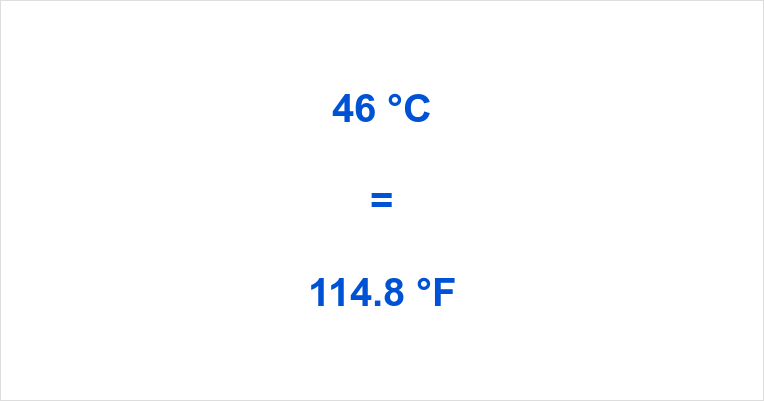When temperatures soar, knowing how to convert Celsius to Fahrenheit can be incredibly useful. Whether you’re planning a summer vacation or just checking the weather, understanding these two scales helps you stay informed. Today, we’ll dive into the specifics of converting 46 Celsius to Fahrenheit and why it matters. With simple formulas and relatable examples, you’ll become a temperature conversion pro in no time! Let’s get started on this enlightening journey through degrees and numbers.
Understanding the 46 Celsius to Fahrenheit
Understanding the conversion from 46 Celsius to Fahrenheit is essential for anyone dealing with temperature measurements. This specific temperature, often encountered in regions experiencing extreme heat, can be quite alarming.
When you hear that it’s 46 degrees Celsius outside, it evokes a sense of urgency regarding hydration and safety. But translating this into Fahrenheit gives us a clearer perspective for those more familiar with that scale.
The calculation reveals how hot it truly feels. It’s not just about numbers; it’s about understanding your environment and making informed decisions based on accurate information.
Being aware of such conversions helps bridge communication gaps between different cultures or travel experiences where Celsius might dominate over Fahrenheit or vice versa.
Converting Celsius to Fahrenheit: The Formula
To convert Celsius to Fahrenheit, there’s a simple formula you can use: multiply the Celsius temperature by 1.8 and then add 32.
For our example of 46 degrees Celsius, the calculation starts with multiplication. Take 46 and multiply it by 1.8, which gives you a result of 82.8.
Next comes the addition step. Add 32 to that number—82.8 plus 32 equals a total of 114.8 degrees Fahrenheit.
This formula is handy for quick conversions in everyday situations, like figuring out how hot it will be outside or adjusting recipes from metric measurements to imperial ones.
Using this method ensures accuracy every time you need to switch between these two widely used temperature scales. It’s straightforward once you get the hang of it!
Simplifying the Conversion Process with Examples
Converting 46 Celsius to Fahrenheit can be straightforward with a simple formula. Start by taking the Celsius temperature and multiplying it by 9/5. Then add 32 to that result.
For example, let’s break it down step-by-step for clarity. First, multiply 46 by 9, which equals 414. Next, divide that number by 5 to get 82.8. Add the constant value of 32.
So when you perform these calculations:
46 °C × (9/5) + 32 = **114.8 °F**.
This method not only helps with converting this specific temperature but also works for any Celsius value you encounter.
With practice, you’ll find yourself comfortable tackling various temperatures efficiently and accurately!
Commonly Used Temperatures in Celsius and their Fahrenheit Equivalents
Understanding commonly used temperatures can make daily life easier, especially when dealing with weather forecasts or cooking.
For instance, water freezes at 0 degrees Celsius, which is equivalent to 32 degrees Fahrenheit. This is a critical temperature for many activities.
When we think about boiling water, it reaches 100 degrees Celsius. In Fahrenheit terms, that’s a steamy 212 degrees.
Room temperature typically hovers around 20-22 degrees Celsius. This translates to approximately 68-72 degrees Fahrenheit—perfect for indoor comfort.
On the cooler side of things, a chilly winter day might measure around -5 degrees Celsius. That equates to around 23 degrees Fahrenheit—a reminder to bundle up!
These conversions help frame our understanding of various climates and situations in everyday life. Knowing these benchmarks makes conversations about temperature more intuitive and relatable.
Benefits of Knowing How to Convert Temperatures
Understanding temperature conversion can greatly enhance your everyday life. It allows you to make sense of weather reports when traveling or living in different countries.
Being able to convert Celsius to Fahrenheit helps you plan outdoor activities according to the climate. You won’t have to worry about packing the wrong clothing for a trip abroad.
In cooking, precise temperature conversions are crucial for perfecting recipes from various cuisines. You’ll be more confident trying out new dishes without second-guessing oven settings.
Moreover, knowing how temperatures relate can aid in health-related decisions, especially concerning extreme weather conditions. Awareness of heat stress or cold exposure becomes easier when you understand the numbers behind them.
It also fosters better communication with friends and family around the world who may use different measurement systems. Engaging in conversations about weather and health becomes much simpler when everyone is on the same page.
Tips for Accurate Temperature Conversion
For accurate temperature conversion, always use a reliable formula. The basic equation is F = (C × 9/5) + 32. This will help you convert Celsius to Fahrenheit efficiently.
Using a calculator can minimize mistakes. Manual calculations may lead to errors, especially if the numbers get complicated.
Double-check your results by converting back. If you convert from Celsius to Fahrenheit and then back again, the result should match your original Celsius reading.
Understanding common reference points helps too. For instance, knowing that water freezes at 0°C or boils at 100°C gives context when working with temperatures.
Practice regularly! The more familiar you become with conversions through real-life examples, the easier it gets over time.
Conclusion
Understanding the conversion from 46 Celsius to Fahrenheit can be essential for various reasons, whether you’re traveling, cooking, or just curious about temperature differences. This knowledge empowers you to better interpret weather reports and make informed decisions based on temperature readings.
The formula used for converting Celsius to Fahrenheit is straightforward: multiply the Celsius value by 9/5 and then add 32. For those wondering how hot 46 degrees Celsius is in Fahrenheit, applying this formula gives us a result of approximately 114.8 degrees Fahrenheit.
To simplify things further, consider some commonly encountered temperatures in both scales. Knowing that water freezes at 0°C (32°F) and boils at 100°C (212°F) provides helpful reference points. Similarly, body temperature is typically around 37°C (98.6°F), making it easier to grasp what different readings mean.
Mastering temperature conversions opens up many benefits. It enhances your ability to cook with precision when following recipes from different countries or helps you adapt your wardrobe according to local weather conditions while traveling abroad.
For accurate conversions every time, keep these tips in mind: always double-check your calculations using reliable sources or tools online if needed—especially when dealing with extreme temperatures like our focal point today of 46 Celsius.
Having a firm grasp on how to convert temperatures can enhance your understanding of daily life scenarios while also enriching conversations about climate and weather patterns globally. Understanding these nuances adds depth not only to discussions but also assists in practical applications across various fields.

















